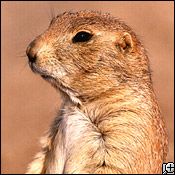The highly social black-tailed prairie dog lives in large subterranean colonies, called townships.
The largest reported township was estimated to contain some 400 million residents and to extend twenty-five thousand square miles (65,000 sq km).
Advertisement
Townships are divided into wards, which are subdivided into coteries, or harems, composed of one or more adult males, several females, and juveniles. A coterie defends its territory — typically less than one acre (0.5 ha) in size — against other coteries.
Diurnal herbivores, prairie dogs spend most of their time above ground, foraging in short- to mid-grass prairie.
Their repertoire of calls may include separate alarm calls for aerial and terrestrial predators.
When township density is high, they may kill up to half of the young of close genetic relatives.
Advertisement
